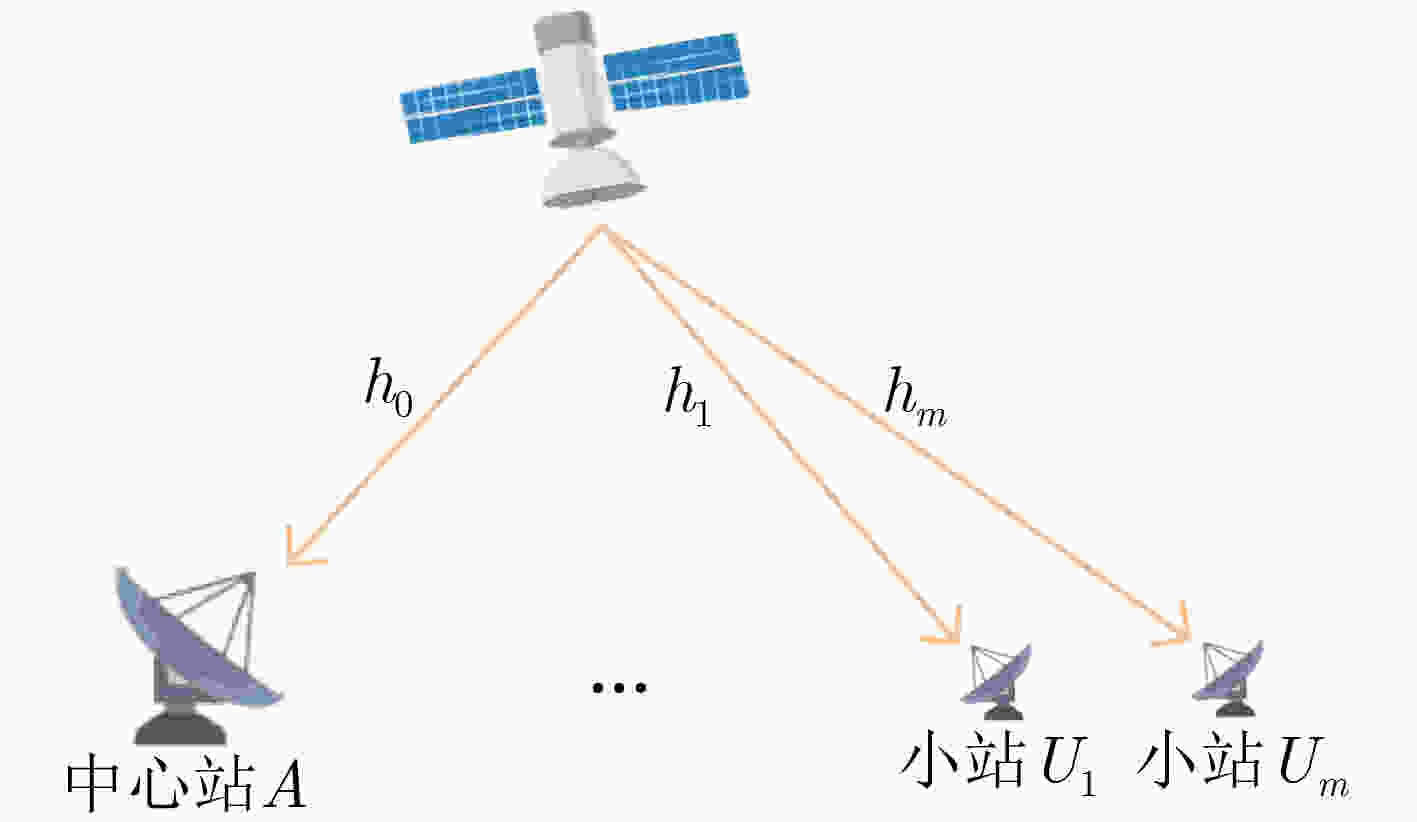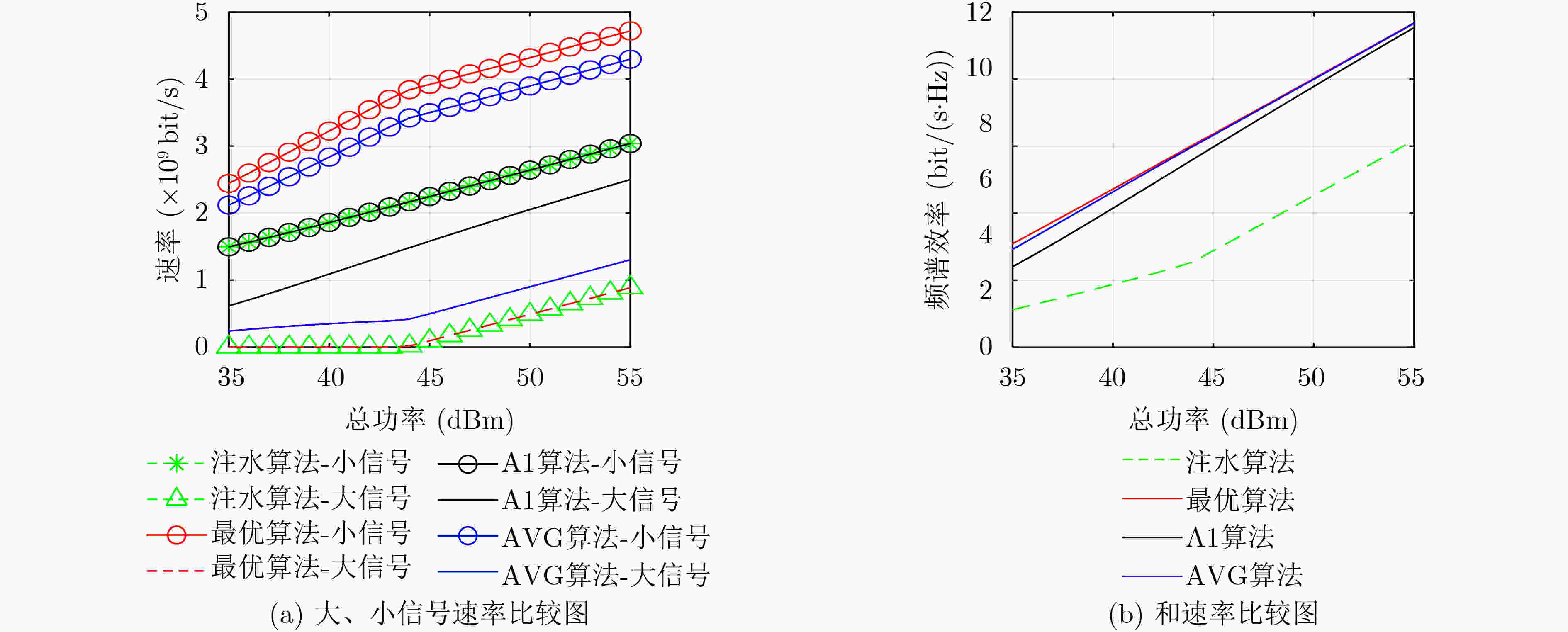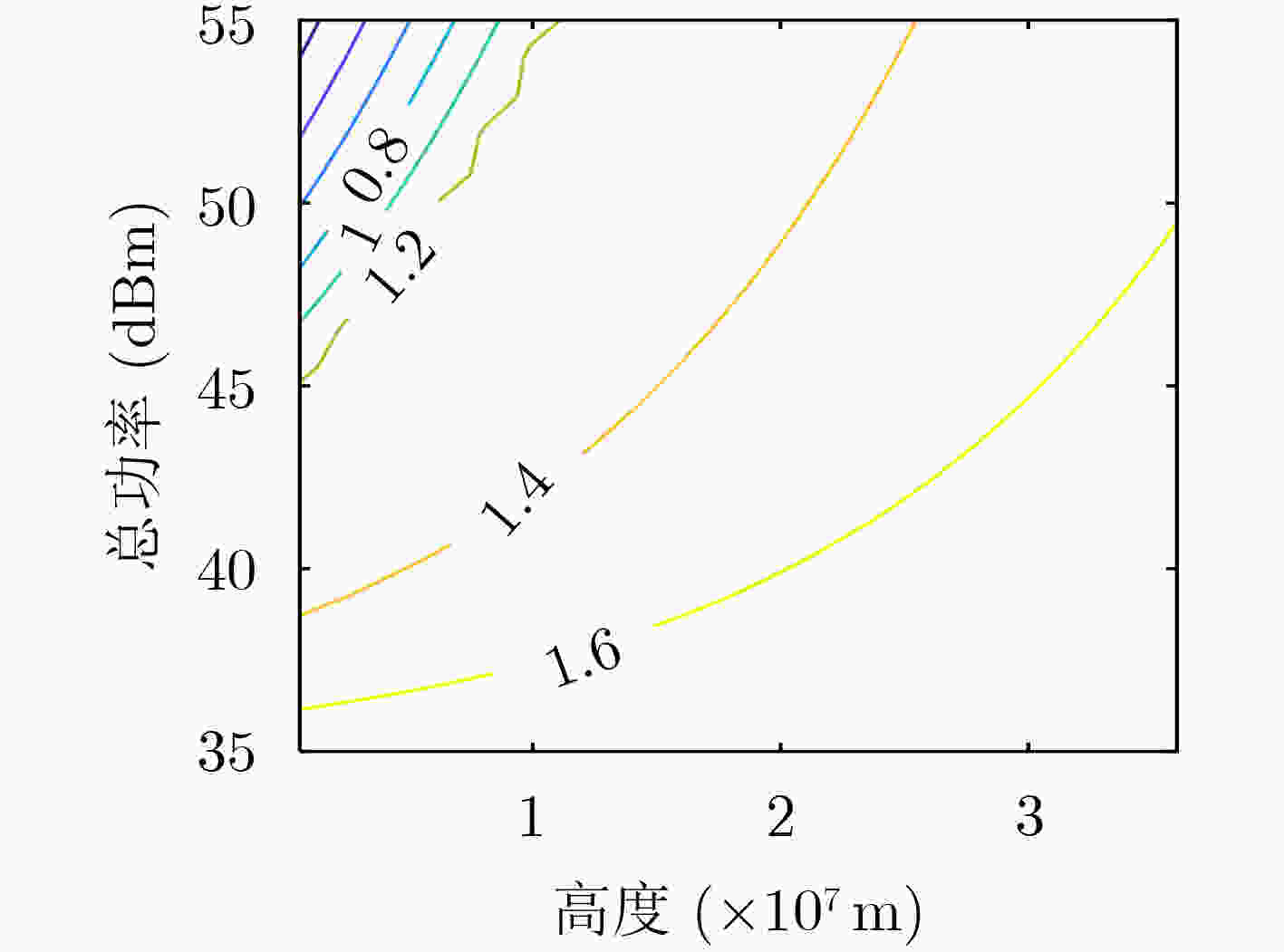Power Allocation Optimization in the Downlink of Asymmetric Paired Carrier Multiple Access Systems
-
摘要: 为提高卫星通信系统的和速率,该文研究了非对称成对载波多址接入(APCMA)系统下行链路的功率分配问题。以最大化系统和速率为目标,在总功率和满足各用户最低服务质量的约束下,通过凸优化的方法,得到了最优功率分配方案,并给出了两种次优功率分配方案。该文以正交多址接入(OMA)中的经典算法作为对比,仿真结果表明,所提功率方案能够最大化和速率,展示了APCMA系统相比OMA系统在频谱效率方面有更优性能。
-
关键词:
- 卫星通信 /
- 非对称成对载波多址接入 /
- 和速率 /
- 功率分配 /
- 服务质量
Abstract: In order to improve the sum rate in the satellite communication system, power allocation in downlink of Asymmetric Paired Carrier Multiple Access (APCMA) system is investigated. Under the constraint of total power and the minimum quality of service for each user, the optimal power allocation scheme is obtained via the methods of convex optimization with the objective of maximizing the sum capacity, and two suboptimal power allocation schemes are given. Compared with the classic algorithm in Orthogonal Multiple Access (OMA), the simulation results show that the proposed scheme in APCMA maximizes the sum rate, and has superior performance in spectral efficiency. -
表 1 非对称PCMA系统下行链路参数表
仿真参数 仿真值 载波频率 20 GHz 转发器带宽 480 MHz 噪声温度 321 K 玻尔兹曼常数 –228 dBW/(K·Hz) 卫星天线增益 54.3 dB 小站的G/T值 2.6 dB/K 中心站的G/T值 12.6 dB/K -
[1] WANG Xiaoyun, SUN Tao, DUAN Xiaodong, et al. Holistic service-based architecture for space-air-ground integrated network for 5G-advanced and beyond[J]. China Communications, 2022, 19(1): 14–28. doi: 10.23919/JCC.2022.01.002 [2] LIU Yi, JIANG Li, QI Qi, et al. Energy-efficient space–air–ground integrated edge computing for internet of remote things: A federated DRL approach[J]. IEEE Internet of Things Journal, 2023, 10(6): 4845–4856. doi: 10.1109/JIOT.2022.3220677 [3] ZHANG Xuejun, ZHU Lina, LI Tian, et al. Multiple-user transmission in space information networks: Architecture and key techniques[J]. IEEE Wireless Communications, 2019, 26(2): 17–23. doi: 10.1109/MWC.2019.1800274 [4] DANKBERG M. Paired carrier multiple access (PCMA) for satellite communication[R]. ViaSat Inc. , 1998. [5] MO Pinghua, FAN Xiaoxing, and YOU Ling. A novel and blind detection scheme for asymmetric PCMA system[C]. 2013 3rd International Conference on Computer Science and Network Technology, Dalian, China, 2013: 854–857. doi: 10.1109/ICCSNT.2013.6967240. [6] ZHAO Yuanke, RAN Xiaomin, LIU Guangyi, et al. A spatiotemporal multi-channel learning framework for PCMA signal detection and recognition algorithm[C]. 2023 4th International Conference on Computer Engineering and Application, Hangzhou, China, 2023: 657–662. [7] FEDER A, HIRSCHBECK M, and GERSTACKER W. Blind estimation of the carrier powers and SNRs in PCMA satellite signals by cyclic statistics[C]. The MILCOM 2022–2022 IEEE Military Communications Conference, Rockville, USA, 2022. [8] 魏驰, 彭华, 郭一鸣, 等. PCMA信号幅度的联合估计算法[J]. 系统工程与电子技术, 2019, 41(2): 433–437. doi: 10.3969/j.issn.1001-506X.2019.02.28WEI Chi, PENG Hua, GUO Yiming, et al. Amplitude joint estimating algorithm for PCMA signals[J]. Systems Engineering and Electronics, 2019, 41(2): 433–437. doi: 10.3969/j.issn.1001-506X.2019.02.28 [9] FEDER A, WICKE W, HIRSCHBECK M, et al. Blind symbol rate and frequency offset estimation for PCMA signals via cyclic correlations[C]. The GLOBECOM 2020–2020 IEEE Global Communications Conference, Taipei, China, 2020. [10] SONG Boxiang, LI Jiping, and CHEN Peng. Estimation algorithm of interference frequency offset in PCMA system[C]. The IEEE 2nd Advanced Information Technology, Electronic and Automation Control Conference, Chongqing, China, 2017: 1094–1097. doi: 10.1109/IAEAC.2017.8054182. [11] 贺伟, 刘晓芳, 宋伟. 变步长LMS算法在PCMA信号相位估计中的应用[J]. 火力与指挥控制, 2022, 47(5): 75–79,85. doi: 10.3969/j.issn.1002-0640.2022.05.011HE Wei, LIU Xiaofang, and SONG Wei. Application of variable step LMS algorithm in PCMA signal phase estimation[J]. Fire Control & Command Control, 2022, 47(5): 75–79,85. doi: 10.3969/j.issn.1002-0640.2022.05.011 [12] FEDER A, GERSTACKER W, and HIRSCHBECK M. Blind symbol timing and carrier phase estimation for PCMA satellite signals via cyclic statistics[C]. 2021 IEEE Global Communications Conference, Madrid, Spain, 2021: 1–7. [13] 王宇琦, 江诗禹, 刘子威, 等. 基于低轨卫星PCMA信号的信道估计算法研究[J]. 光通信研究, 待发表.WANG Yuqi, JIANG Shiyu, LIU Ziwei, et al. Research on channel estimation algorithm based on LEO satellite PCMA signal[J]. Study on Optical Communications, To be published. [14] 付君, 彭华, 郭一鸣, 等. 一种非数据辅助PCMA信号参数联合估计算法[J]. 信息工程大学学报, 2018, 19(5): 574–579. doi: 10.3969/j.issn.1671-0673.2018.05.013FU Jun, PENG Hua, GUO Yiming, et al. Non-data aided joint parameters estimation algorithm for PCMA signals[J]. Journal of Information Engineering University, 2018, 19(5): 574–579. doi: 10.3969/j.issn.1671-0673.2018.05.013 [15] 贾子欣, 陈卫东, 杨松. PCMA信号调制识别研究[J]. 电子测量技术, 2020, 43(20): 133–138. doi: 10.19651/j.cnki.emt.2004934JIA Zixin, CHEN Weidong, and YANG Song. Research on PCMA signal modulation recognition[J]. Electronic Measurement Technology, 2020, 43(20): 133–138. doi: 10.19651/j.cnki.emt.2004934 [16] 李林俊, 戴旭初. 基于CNN的PCMA信号调制识别方法[J]. 遥测遥控, 2019, 40(4): 17–22. doi: 10.13435/j.cnki.ttc.003013LI Linjun and DAI Xuchu. A modulation identification approach for PCMA signals based on convolutional neural networks[J]. Journal of Telemetry, Tracking and Command, 2019, 40(4): 17–22. doi: 10.13435/j.cnki.ttc.003013 [17] DENG Qi, ZHANG Shanshan, CHEN Gang, et al. Blind separation of PCMA signals based on iterative quantum genetic optimization[C]. 2019 International Conference on High Performance Big Data and Intelligent Systems, Shenzhen, China, 2019: 35–40. [18] YANG Yong, PENG Hua, ZHANG Dongling, et al. Markov chain Monte Carlo-based separation of paired carrier multiple access signals[J]. IEEE Communications Letters, 2016, 20(11): 2209–2212. doi: 10.1109/LCOMM.2016.2599874 [19] ISLAM S M R, AVAZOV N, DOBRE O A, et al. Power-domain non-orthogonal multiple access (NOMA) in 5G systems: Potentials and challenges[J]. IEEE Communications Surveys & Tutorials, 2017, 19(2): 721–742. doi: 10.1109/COMST.2016.2621116 [20] KUMAR A, PERVEEN S, SINGH S, et al. 6th Generation: Communication, signal processing, advanced infrastructure, emerging technologies and challenges[C]. 2021 6th International Conference on Computing, Communication and Security, Las Vegas, USA, 2021: 1–16. [21] GAO Zhixiang, LIU Aijun, HAN Chen, et al. Sum rate maximization of massive MIMO NOMA in LEO satellite communication system[J]. IEEE Wireless Communications Letters, 2021, 10(8): 1667–1671. doi: 10.1109/LWC.2021.3076579 [22] YANG Zhaohui, XU Wei, PAN Cunhua, et al. On the optimality of power allocation for NOMA downlinks with individual QoS constraints[J]. IEEE Communications Letters, 2017, 21(7): 1649–1652. doi: 10.1109/LCOMM.2017.2689763 [23] WANG Jun, XU Hongbo, FAN Lvrong, et al. Energy-efficient joint power and bandwidth allocation for NOMA systems[J]. IEEE Communications Letters, 2018, 22(4): 780–783. doi: 10.1109/LCOMM.2018.2794521 [24] BOYD S and VANDENBERGHE L. Convex Optimization[M]. Cambridge: Cambridge University Press, 2004: 535–593. [25] TIAN Lu, WANG Shuai, CHENG Zhiheng, et al. All-digital self-interference cancellation in zero-IF full-duplex transceivers[J]. China Communications, 2016, 13(11): 27–34. doi: 10.1109/CC.2016.7781715 [26] 赵佳颖, 洪涛, 张更新. 一种基于机器学习的卫星重叠隐蔽通信方法[J]. 信号处理, 2023, 39(3): 482–495. doi: 10.16798/j.issn.1003-0530.2023.03.011ZHAO Jiaying, HONG Tao, and ZHANG Gengxin. A satellite covert overlap communication method based on machine learning[J]. Journal of Signal Processing, 2023, 39(3): 482–495. doi: 10.16798/j.issn.1003-0530.2023.03.011 [27] 代健美, 文泓斐. Starlink星地链路性能仿真分析与启示[J]. 通信技术, 2022, 55(12): 1589–1596. doi: 10.3969/j.issn.1002-0802.2022.12.011DAI Jianmei and WEN Hongfei. Simulation and enlightenment of Starlink satellite ground link performance[J]. Communications Technology, 2022, 55(12): 1589–1596. doi: 10.3969/j.issn.1002-0802.2022.12.011 [28] GAO Zhixiang, LIU Aijun, and LIANG Xiaohu. The performance analysis of downlink NOMA in LEO satellite communication system[J]. IEEE Access, 2020, 8: 93723–93732. doi: 10.1109/ACCESS.2020.2995261 [29] LOUIS J. Satellite Communications Systems Engineering[M]. Beijing: National Defense Industry Press, 2012: 265. [30] CHO Y S. MIMO-OFDM Wireless Communications with MATLAB[M]. Beijing: Publishing House of Electronics Industry, 2014: 119–121. [31] HE P, ZHAO Lian, ZHOU Sheng, et al. Water-filling: A geometric approach and its application to solve generalized radio resource allocation problems[J]. IEEE Transactions on Wireless Communications, 2013, 12(7): 3637–3647. doi: 10.1109/TWC.2013.061713.130278 [32] KOBAYASHI M and CAIRE G. An iterative water-filling algorithm for maximum weighted sum-rate of Gaussian MIMO-BC[J]. IEEE Journal on Selected Areas in Communications, 2006, 24(8): 1640–1646. doi: 10.1109/JSAC.2006.879410 -






 下载:
下载:





 下载:
下载:
